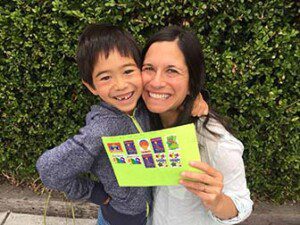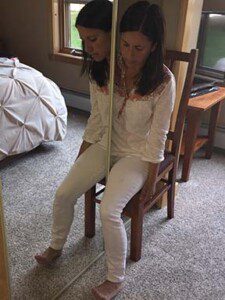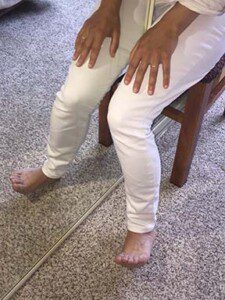 Written by Julie Robbins, OTR/L for the RSDSA blog.
Written by Julie Robbins, OTR/L for the RSDSA blog.
I am a passionate, pediatric occupational therapist. I am also an adoring mother of a 7 year old, a loving wife, a minimalist, a book clubber, a political activist, an animated Zumba-er, a Korean language student, a loyal friend and family member, a volunteer, and therefore, a multitasker. A few months ago, I became a patient too.
I was multi-tasking (read: rushing) when I stubbed my middle three toes of my right foot, hard. After an x-ray and MRI and several appointments with just as many healthcare professionals, it turns out I likely fractured my middle toe in two places and developed a rare, nervous system response to this injury of an appendage: chronic regional pain syndrome (CRPS), previously called reflex sympathetic dystrophy (RSD).
The NIH describes CRPS as: “…prolonged severe pain that may be constant. [CRPS] has been described as ‘burning,’ ‘pins and needles’ sensation, or as if someone were squeezing the affected limb” (“Complex Regional Pain Syndrome Factsheet,” 2018). For me, sometimes it felt as if my big toe was being impaled by a razor-sharp metal splinter and at other times it felt as if the right side of my body was being burned by ice. The American RSDHope website states “CRPS is ranked as the most painful form of chronic pain that exists today by the McGill Pain Index (“CRPS Overview/Description,” 2017). Further research implies that there is a strong mind-body connection leading to this diagnosis and most of the statistics suggest a negative and undesirable outcome.
I was opportunely diagnosed with CRPS by a lecturing physical therapist during a work conference I happened to attend. Starting the following week, this diagnosis was confirmed by my podiatrist, primary care physician, ankle foot orthopedic surgeon, and my physical therapist.
I had an extremely positive experience with this unusual and undesirable label.
My physical therapist joked that I am a “Type B personality who attacked this diagnosis in a Type A manner.” I think what she meant was that I utilized a variety of traditional and non-traditional techniques in a systematic and diligent manner. I joked that I hired myself for an “unpaid part-time internship” in my own healing. What I meant is that I dedicated 2-3 hours per day, 7 days per week toward my healing. This required me to minimize most of my roles and responsibilities for about three months. Luckily, I have a stalwart support system in my life, and was provided this necessary latitude.
I tried over 30 different techniques, modalities and supplements to address my healing. I am able to recall each of them with detail because I kept a journal. Although I wrote this journal for my own healing, I am authoring this article to support other people’s healing. Below are many of the techniques that aided in my relatively fast recovery from CRPS.
Healing Technique 1: Journaling
This started as a means to document my feelings. This diagnosis is reputed to be layered with many negative feelings. My journal then transitioned to become a place where I was able to document everything I was trying, my short and long term goals (yes, I wrote functional, meaningful and measurable goals for myself) and my P.T.-prescribed exercises and stretches.
Healing Technique 2: Semantics
Almost a decade ago, I learned about “Hypnobirthing,” a theory and techniques used to facilitate a desired natural child birth. One thing in particular about Hypnobirthing that resonated with me was renaming a physical sensation in a positive way to help manage a physical response (Mongan, 2005). Examples of this in Hypnobirthing include using the word “surge” instead of “contraction” and saying “sensation” instead of “pain.” I successfully used this technique by mirroring this and only using the word “sensation” (even when constantly asked to rate my pain out of 10) instead of “pain,” saying “healing foot” instead of “hurt or injured foot” and informally renaming the entire diagnosis to become Mystery Sensation Syndrome (MSS) instead of Chronic Regional Pain Syndrome.
Healing Technique 3: Mirror Therapy
Before practicing 2-5 minutes of this, there were obvious color changes, differences in girth related to edema, and even texture changes on my healing foot. I sat in a chair and positioned a mirrored, sliding, closet door at my midline. With bare feet, I placed my healing right foot behind the mirror and my left foot in front of it. I moved my feet in a synchronized manner, plantarflexing and dorsiflexing both feet, etc. While moving my feet, I watched my left foot and its reflection (which looked like my right foot.) After 2-5 minutes of this, the color, girth, and texture of my feet appeared typical and matched each other.
Healing Technique 4: Sensory Input
As I was still waiting for my broken toe to heal, I needed to be gentle with treating my MSS. As tolerated, I wrapped an ace bandage around my foot, ankle, and lower leg. Other types of sensory input that I used included placing both bare feet in tubs of dried beans and dried rice, wearing different textured socks, rubbing rough and soft textured fabrics on my feet, and placing my healing foot and leg near the jet in a heated pool.
Healing Technique 5: Loading
As soon as my broken middle toe was confirmed as “healed enough” by an orthopedic surgeon, I started weight bearing. At the time, this felt like a challenging recommendation since I had intermittently been using crutches for community mobility and even a wheelchair in the airport and at a museum.
Healing Technique 6: Sensation Tolerance “Raise by One”
When weight bearing, providing sensory input, etc., I was cognizant to only increase my rated “sensation level” by one point. For example, if I rated my “sensation level” at 5/10, then I would only keep my ace wrap on if it remained at a 6/10, but if my sensation level started to raise by two points, to 7/10, I would remove the wrap immediately. Remaining patient with my progress, I consistently kept to this rule of “Raise by One” for each exercise, stretch, and modality that I tried.
Healing Technique 7: Heated Pool
Like many people with this diagnosis, temperature changes were one of my biggest challenges. Before I was correctly diagnosed, I was very confused why I could not withstand the “pain” of briefly standing in front of my open refrigerator. I went in a heated pool four days per week for 30+ minutes per day. Initially, I walked with the support of a pool noodle under my arms. I walked forward, backward, sideways, and grapevined. Eventually, I removed the noodle, transitioned to a shallower part of the pool, and added small jumps and runs, and kicked in different positions while swimming.
Healing Technique 8: Positive Reinforcement
Sticker charts are not just for my son and my pediatric clients at work. I created a very simple sticker chart and gave myself one “Fantastic!” sticker each time I had an (initially forced) positive mental attitude (PMA) about the outcome of my healing process. After each set of ten stickers, my son (for being such an amazing support) and I earned a special treat, such as pomegranate seeds or getting to sleep in on the weekend.
Healing Technique 9: Meditation
This is proven to be good for all of us, and it is especially important with this diagnosis. My family and I used Apps, such as “Headspace” (Headspace, Inc., 2018) to meditate together. I also meditated while stretching on land and in the pool.
Healing Technique 10: Visualization
I often closed my eyes to picture my two healthy feet doing all of the things that two healthy feet can do: Zumba, walking A LOT, biking, running, cross country skiing, hiking, and jumping. I also looked at a lot of pictures of women’s feet.
Healing Technique 11: De-stress
I eliminated things in my life that may contribute to stress. This is different for everyone. For me, it turned out that I needed to take a break from listening to current events and from political activism. I also reduced my over-scheduled social and volunteer calendar.
Healing Technique 12: Laughter
I watched less television and started reading more. However, when I did watch T.V., I chose comedies, such as “Parks and Recreation.” I also chose books with relatively light topics.
Healing Technique 13: Sleep
I re-prioritized sleep. I improved my sleep hygiene and I worked hard to get 8-9 hours of sleep per night.
Healing Technique 14: Acupuncture
I went to a sliding-scale community acupuncture clinic two times per week. The acupuncturist focused on points related directly to my diagnosis, stress, and circulation. I also used a special heated light called a TDP Mineral Therapy Lamp during these sessions which appeared to aide in my healing.
Healing Technique 15: Seamless Socks
I tried a variety of seamless socks and found the ones without compression worked best for me. The brand I wear is called Sierra Socks women’s diabetic 100% cotton ankle turn cuff socks.
Healing Technique 16: Essential Oils
I used a “Stress-Less Blend” oil (melissa, lavender, cedarwood, frankincense with an almond and avocado oil base) everyday on the bottoms of my feet.
Healing Technique 17: Physical Therapy
I did a variety of prescribed stretches and exercises. My P.T. followed my lead and listened closely to my responses to modalities that she tried. It was helpful when she reminded me to pace myself when I overdid my exercises.
Healing Technique 18: TENS Unit
“Transcutaneous electrical nerve stimulation (TENS) is a nonpharmacologic treatment for pain relief. TENS has been used to treat a variety of painful conditions” (DeSantan, et al, 2008).
I used a home unit two times per day for about two weeks. I encircled the CRPS by placing the pads around the areas with the most prominent sensation that day.
I am passionate about many things, including my own and others’ healing. I am starting to regain many of the valuable roles in my life that I had needed to minimize for a while. And now, I have added an additional role: I am a writer.


REFERENCES
American RSDHope (2017). Retrieved from http://www.rsdhope.org/what-is-crps1.html
DeSantan, Josimari M., Walsh, Deirdre M., Vance, Carol, Rakel, Barbara A., Sluka, Kathleen A. (2008). Effectiveness of Transcutaneious Electrical Nerve Stimulation for Treatment of Hyperalgesia and Pain. Curr Rheumatol Rep., 10(6): 492–499. Retrieved from https://www.ncbi.nlm.nih.gov/pmc/articles/PMC2746624/
Headspace (2017). Retrieved from https://www.headspace.com/headspace-meditation-app
Mongan, M. F. (2005). Hypnobirthing: The Mongan Method: A Natural Approach To a Safe, Easier, More Comfortable Birthing (3rd Edition), 67-72.
National Institute of Neurologic Disorders and Stroke (2018). Retrieved from https://www.ninds.nih.gov/Disorders/Patient-Caregiver-Education/Fact-Sheets/Complex-Regional-Pain-Syndrome-Fact-Sheet
